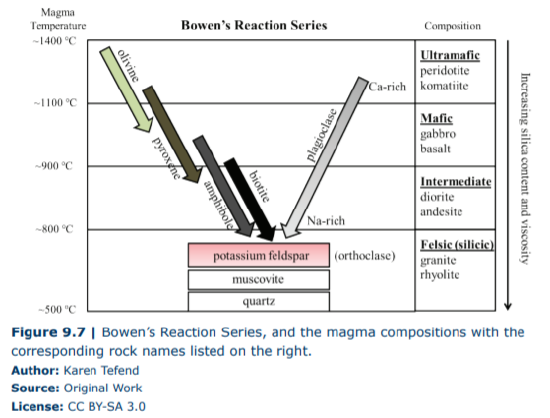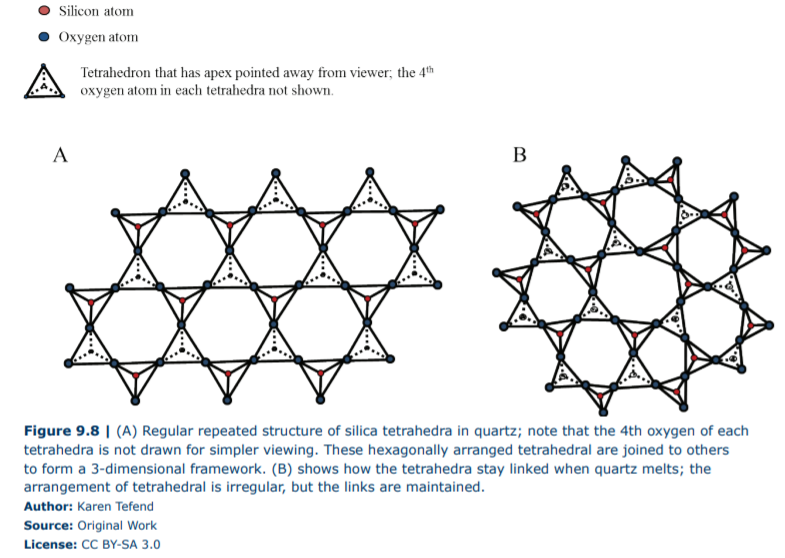9.6: Magma Composition and Viscosity
- Page ID
- 5624
Overview
In the chapter on igneous rocks, you learned that the igneous rock classification is in part based on the mineral content of the rock. For example, ultramafic rocks are igneous rocks composed primarily of olivine and a lesser amount of calcium-rich plagioclase and pyroxene, whereas quartz, muscovite and potassium feldspar are the typical minerals found in felsic rocks (Figure 9.7). We need to review the mineral content of these rocks, because igneous rocks are the crystallized result of cooled magma, and the minerals that form during cooling depend on the chemical composition of the magma; for example, a mafic magma will form a mafic rock containing a large amount of the ferromagnesian minerals pyroxene and amphibole, but will not contain quartz (the mineral that is always present in felsic rocks)

Recall that most of the minerals in igneous rocks are silicate minerals, and all of the minerals shown in Bowen’s Reaction Series belong to the silicate mineral group. All silicate minerals have crystal structures containing silica tetrahedron (a silicon atom linked to four oxygen atoms), and these silica tetrahedra can be linked in a variety of ways to form sheets, linked chains, or a 3-dimensional framework. The lower temperature minerals (quartz, muscovite and orthoclase) have more linked tetrahedra than the high-temperature minerals (olivine and pyroxene). Figure 9.8A shows how the silica tetrahedra are linked to form the mineral quartz. Note that this is a 2-dimensional diagram of a 3-dimensional structure, and there are a lot more tetrahedra connected in the area above and behind the typed page. What is important about this figure is what happens to the silica tetrahedra when quartz melts; Figure 9.8B shows that even though the crystal structure is lost (the regularly repeated structure is gone), the tetrahedral links are maintained, albeit distorted. The bonds that link these tetrahedra are strong, and magma temperatures are not high enough to break these bonds. This means that magmas that can crystallize quartz will have a lot of these tetrahedra linked in the magma, whereas mafic magmas which do not contain enough silicon to crystallize quartz, will instead crystallize minerals that have fewer linked tetrahedra.

Why does the silica content (the amount of linked tetrahedra) of magma matter so much? A large amount of linked silica tetrahedra will result in magma or lava that is very viscous, meaning that it cannot flow easily (viscosity means resistance to flow). The temperature of lava also affects the viscosity; think of how ketchup from your refrigerator flows and how ketchup stored in your pantry flows; of these two fluids, the colder ketchup has the higher viscosity. In the case of magmas or lavas, the hotter the lava, the easier it flows, and the less silica that is present, the lower the viscosity (see right side of the diagram in Figure 9.7). This means that mafic lavas can flow faster than intermediate or felsic lavas. The silica content of magma affects not only the shape of the volcano but the style of eruption, whether an eruption will be lava that flows, or a magma that blows (up).


